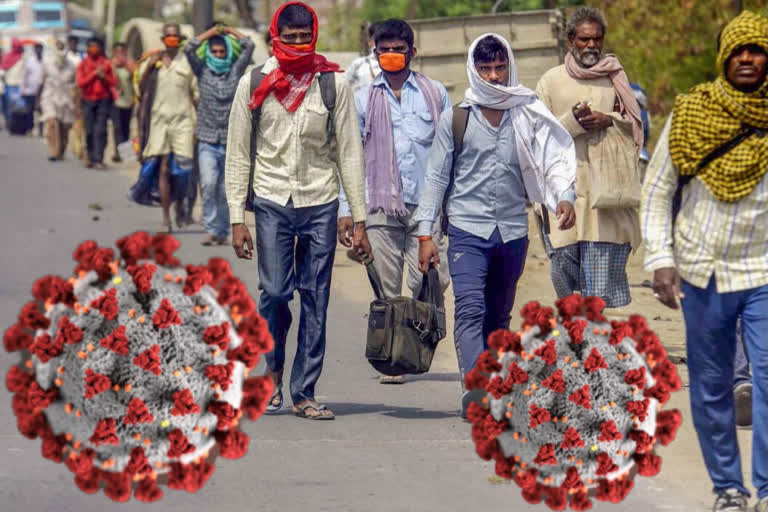New Delhi: India enters the fifth phase of lockdown but the cases of COVID-19 is seemingly increasing with India registering 182,142 confirmed cases with 5,164 deaths as on May 31 as per the statistics of the Ministry of Health and Family Welfare. The situation seems grimmer than ever.
Experts are prerogative of the fact that the lockdown had failed to contain community transmission of infections as millions of migrant workers and the poor including daily wage earners were instantly left jobless, homeless and took to the street to reach home, after the government announced a nationwide lockdown on March 24 to combat the spread of the virus.
The lockdown has resulted in a heavy influx of migrant workers all across the nation and to prevent the mass exodus, the state governments were instructed to prohibit movement and transportation of migrant labourers and shift them to relief shelter homes and relief camps instead, which turned out to be even worse as staying in one campus makes it difficult rather impossible to adhere to the norms of social distancing and self-isolation with no basic facilities available.
However, it is becoming clear that lockdown of the migrant workers in Indian dormitories has caused the spread of the COVID-19.
Read: Possible rise in COVID-19 cases? MP govt readies 60,000 beds
Speaking to ETV Bharat, Dr Abhay Shukla, National Co-convenor, Jan Swasth Abhiyan said, "The issue of migrant workers was not addressed promptly. The lockdown was imposed with 4 hours of notice which left millions of people stuck which itself was extremely short-sighted. Other countries have imposed lockdown with proper preparation with 5-6 days' notice period to travel back and people are kept under proper condition, they are at least not stranded inroads. When travel is not planned properly, it becomes chaos. That is what has happened in India".
"In the whole process of urban planning, the government has failed to plan for a proper space, workers colony or workers habitation in metropolitan cities, so the labourers are forced to reside in highly overcrowded places. So, naturally, if one person develops the infection, it will affect the rest", he underlines.
"These are not conducive at all to control the pandemic, it is a poorly planned lockdown which did not take into account the issue of the migrants and then later on when it emerged into public consciousness, some far-sighted measures were taken which are quite insufficient. Overall, the lockdown has not helped in containing COVID-19. There are other measures which could have been far more effective", he told ETV Bharat.
He recommends that the government should treat the workers as a high priority and the migrant crisis should be treated as a national emergency. The centre should ensure interstate coordination, a separate task force for migrant workers should be created to ensure that coordination takes place as a topmost priority.
Migrant workers are put up in shelters before they are even transported to their place.
On the other hand, migrants who reached back are under institutional quarantine with no better facilities, which has led to the transmission of the disease.
"We don't have large scale dormitories in India for workers as such, in most cases, migrants are leaving in informal settlements, low-income settlements or some kind of temporary arrangements in larger cities, they are leaving in a crowded condition where the possibility of spreading of diseases is more", he cited
Shukla also said, "Community transmission had started in April itself in most of the states with some exceptions like Kerala, which was able to control the transmission to a very large extent. It started in Mumbai, Pune and Delhi from early April, and the acceleration in several cases co-relates with that."
Read: ICMR study says sustained HCQ intake reduces risk of coronavirus in healthcare workers
"Until the end of March, the number of cases were rising in arithmetical progression but from early April onwards, it became more like a geometrical progression which became exponential. That was because of community transmission. Within the community-based transmission in large urban areas, the informal workers and migrants are affected the most and facing the worst humanitarian crisis with and the transmission increasing eventually", he further added.
Shukla said, "For instances, in countries like South Korea where COVID-19 is contained primarily by Intensive testing, isolation of cases, contact tracing, home quarantine of contacts, and rigorous follow-ups, which are not being done sufficiently in India. Early containment of the pandemic could have been possible in the initial stage."
"In larger urban areas like Mumbai, the objective has to be now to reduce transmission and minimize deaths. People with co-morbidity should be detected and treated early. Micro containment zones should be maintained with regular testing that can help to keep the transmission low", he points out.
Shukla further stated, "Fund should be created; we cannot exploit the labourers as they are an important asset to the country contributing largely to the economic growth."
As per reports, as of May 30, as many as 2,433 migrants who have returned to Bihar have tested positive for the coronavirus and a majority of them have returned from places like Maharashtra, Delhi, Gujrat, Haryana, UP, Rajasthan, Telangana, West Bengal. These contributed 68.24 per cent of the total confirmed COVID -19 cases in Bihar.
Also Read: Recovery rate rising, case fatality going down: Health Ministry



